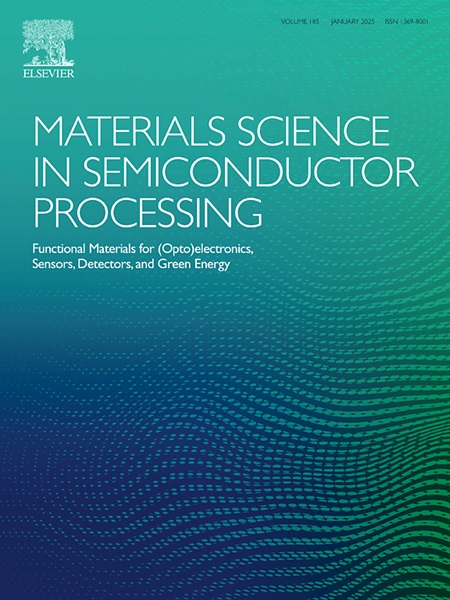基于机器学习的光催化非晶/晶TiO2纳米复合材料的设计
IF 4.6
3区 工程技术
Q2 ENGINEERING, ELECTRICAL & ELECTRONIC
引用次数: 0
摘要
调整二氧化钛(TiO2)结构中相组成的能力对于定制其性能以适应各种应用至关重要。然而,传统的方法很难准确地预测和调节这些材料中非晶相和结晶相之间的平衡。在这里,我们介绍了一种创新的方法,利用机器学习(ML)技术,基于热重分析(TGA)数据来预测和分类TiO2纳米复合材料中非晶相与晶相的比例。在1°C/min、5°C/min、10°C/min和20°C/min的升温速率下进行非等温热重分析实验,获得数据集。采用了Adaboost、决策树(DT)回归、高斯过程回归(GPR)、k-最近邻回归(KNN)、线性回归(LR)、多层感知器(MLP)、随机森林回归(RF)、支持向量机回归(SVM)和XGBoost (XGB)等多种ML算法。通过训练和测试数据的r平方(R2)、均方根误差(RMSE)和平均绝对误差(MAE)指标来评估模型的性能。其中,GPR、KNN、RF和XGB是表现最好的算法,GPR的R2值为0.999,错误率最低(RMSE: 2 × 10−4,MAE: 2.4 × 10−5)。因此,GPR被认为是最成功的回归模型。在分类部分,XGB算法达到了99.9%的最高准确率,DT、RF和XGB在True Positive Rate (TPR)和False Positive Rate (FPR)指标上也表现出色。这些发现突出了机器学习技术在优化TiO2纳米复合材料相组成预测和分类方面的潜力,从而减少了时间尺度、成本和严格的计算。本文章由计算机程序翻译,如有差异,请以英文原文为准。
Design of the amorphous/crystalline TiO2 nanocomposites via machine learning for photocatalytic applications
The ability to adjust the phase composition in titanium dioxide (TiO2) structures is crucial for customizing their properties to fit various applications. However, traditional approaches struggle to accurately forecast and regulate the balance between amorphous and crystalline phases within these materials. Here, we introduced an innovative method, utilizing machine learning (ML) techniques, to predict and classify the ratio of amorphous to crystalline phases in TiO2 nanocomposites based on thermogravimetric analysis (TGA) data. Non-isothermal TGA experiments were conducted at heating rates of 1 °C/min, 5 °C/min, 10 °C/min, and 20 °C/min to obtain dataset. Various ML algorithms including Adaboost, Decision Trees (DT) Regression, Gaussian Process Regression (GPR), k-Nearest Neighbor Regression (KNN), Linear Regression (LR), Multi-Layer Perceptron (MLP), Random Forest Regression (RF), Support Vector Machine Regression (SVM) and XGBoost (XGB) were employed. The performances of models were evaluated by the R-squared (), root mean square error (RMSE) and mean absolute error (MAE) metrics for training and test data. Among these, GPR, KNN, RF, and XGB emerged as the top-performing algorithms, with GPR achieving an exceptional R2 value of 0.999 and the lowest error rates (RMSE: 2 × 10−4, MAE: 2.4 × 10−5). Thus, GPR was identified as the most successful regression model. As for classification part, the XGB algorithm achieved the highest accuracy of 99.9 % with DT, RF, and XGB also excelling in True Positive Rate (TPR) and False Positive Rate (FPR) metrics. These findings highlight the potential of ML techniques in optimizing phase composition prediction and classification for TiO2 nanocomposites, thereby reducing timescales, cost, and rigorous calculations.
求助全文
通过发布文献求助,成功后即可免费获取论文全文。
去求助
来源期刊

Materials Science in Semiconductor Processing
工程技术-材料科学:综合
CiteScore
8.00
自引率
4.90%
发文量
780
审稿时长
42 days
期刊介绍:
Materials Science in Semiconductor Processing provides a unique forum for the discussion of novel processing, applications and theoretical studies of functional materials and devices for (opto)electronics, sensors, detectors, biotechnology and green energy.
Each issue will aim to provide a snapshot of current insights, new achievements, breakthroughs and future trends in such diverse fields as microelectronics, energy conversion and storage, communications, biotechnology, (photo)catalysis, nano- and thin-film technology, hybrid and composite materials, chemical processing, vapor-phase deposition, device fabrication, and modelling, which are the backbone of advanced semiconductor processing and applications.
Coverage will include: advanced lithography for submicron devices; etching and related topics; ion implantation; damage evolution and related issues; plasma and thermal CVD; rapid thermal processing; advanced metallization and interconnect schemes; thin dielectric layers, oxidation; sol-gel processing; chemical bath and (electro)chemical deposition; compound semiconductor processing; new non-oxide materials and their applications; (macro)molecular and hybrid materials; molecular dynamics, ab-initio methods, Monte Carlo, etc.; new materials and processes for discrete and integrated circuits; magnetic materials and spintronics; heterostructures and quantum devices; engineering of the electrical and optical properties of semiconductors; crystal growth mechanisms; reliability, defect density, intrinsic impurities and defects.
 求助内容:
求助内容: 应助结果提醒方式:
应助结果提醒方式:


